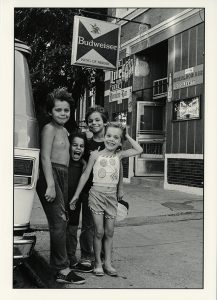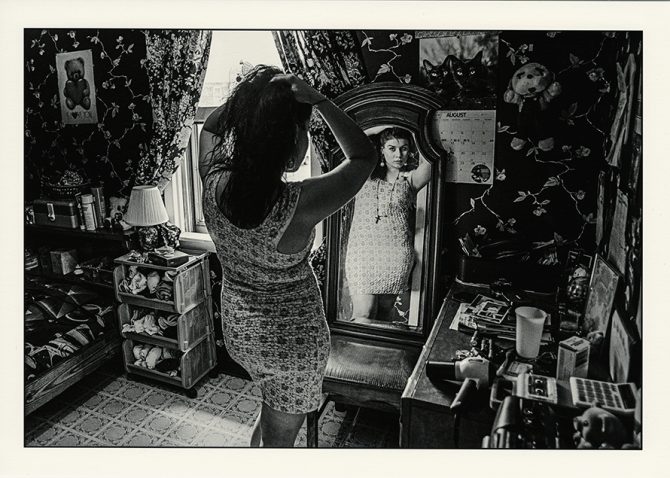Chicago is known for its neighborhoods, each suffused with a specific experience and mentality of the people who live there. I grew up in the northwest neighborhood of Hermosa, small but nonetheless its own neighborhood, and the place I call home. My mother, on the other hand, grew up in Pilsen in the early 1990s, and when we were young, she made a point to have us visit her old neighborhood and show us around. Visiting Pilsen, myself as a kid, I still had never known what it was like for my mother to grow up there in the 90s since she didn’t have many photos from that time of her life.
It wasn’t until I saw photos through the recently acquired Akito Tsuda Photographs collection, now housed in the Special Collections at Harold Washington Library Center, that I was able to get a glimpse into Pilsen as it was in the 1990s.
Growing up in Mexican culture in Hermosa versus in Pilsen can be two different experiences, given that Chicago neighborhoods are so vibrant and unique. Through Tsuda’s collection, I feel lucky to have gained a new perspective for what it was like for my mom to live in her neighborhood during that time. Tsuda’s photographs capture a vividness of the Mexican American culture that still exudes when you drive through Pilsen today. While looking through the photographs you can’t help but feel the pride, community and humanness that Tsuda is so sharply, yet so heartwarmingly, able to capture.
My mom grew up living with her cousins, aunts, uncles, my grandma and my great grandma in an apartment building near 18th Street. Many of those uncles I didn’t get the chance to meet, as most of them passed before I was born or when I was a baby. This photo by Tsuda captures how I imagine my mom when she was younger – out on a warm day hanging out with her cousins and tíos without a care in the world (besides how cool her uncles were, since they were much older and knew everything about everything).
One of my favorite stories to hear from my mom growing up in Pilsen was how one of her aunts would take her and her cousins out to the bars to sell those small packs of gum. Of course, since they were kids then, they had a great time. This photo by Tsuda embodies the imagery I had in mind when listening to my mom retell the story – the innocence and fun of being kids, hanging outside a bar in Pilsen.
Looking through the Tsuda photograph collection, one of my favorite photos is where he captured a young woman getting ready in the full-size mirror that sits in the bedroom.
Through this image, Tsuda captures an emotional intensity with the framing – we can indirectly observe the girl’s face through the mirror, a look somewhere between soft and harsh that holds so much power. The drama of her expression is highlighted by the sunlight, in contrast to the darker parts of the bedroom, with its soft decorations and floral wallpaper.
My mom didn’t grow up with many girl cousins her age, so she often talks about the times of how her aunts, who were about ten years older than her, would dress her up the way they used to dress up for parties and concerts. For that reason, I think that is why this is one of my favorite photos of Tsuda’s collection. With this photo I imagine this is the influence of pride my mom felt observing her aunts when she was young, and what she has passed down in influencing me as her daughter. A pride that we carry that starts in the home with our loved ones and that exudes when we look in the mirror.
Tsuda’s photographs are especially heartwarming because he’s able to capture an intimacy of what it means growing up in the Mexican American culture that often is hard to explain besides saying “you just had to be there.” With this image, of a man sitting against a wrecked car against a graffiti filled wall playing guitar, Tsuda captures a resilience that embodies our culture with such a sharp eye that magnifies that humanness that you can’t help but feel like you were right there when this moment happened.
When my mom saw this photo, she recognized some of the graffiti and went into being transported back to Pilsen in the '90s when she was a young girl. When she would take me and my siblings to visit Pilsen when we were kids, some things had changed, although some things were the same, so we had a different experience of the same Pilsen. Thanks to Tsuda capturing these images, many of us can now go down memory lane – not necessarily our personal memory lane (although for some that’s true), but the memory lane of our people.
Akito Tsuda seems to have his eye rooted in intimateness that allows for his photos to display what it means to be human, which is the best lens when observing the world because it allows our empathy to lead in all that we do and how we interact with one another.
If you’re looking to see Pilsen captured in the ‘90s make an appointment to visit the Special Collections at Harold Washington Library Center to view the Akito Tsuda Photographs Collection. Also keep an ear and eye out for an exhibit opening in 2024 at the Harold Washington Library Center that will feature Akito Tsuda’s photographs.







Add a comment to: Pilsen Captured in the ‘90s With CPL’s Akito Tsuda Archival Collection